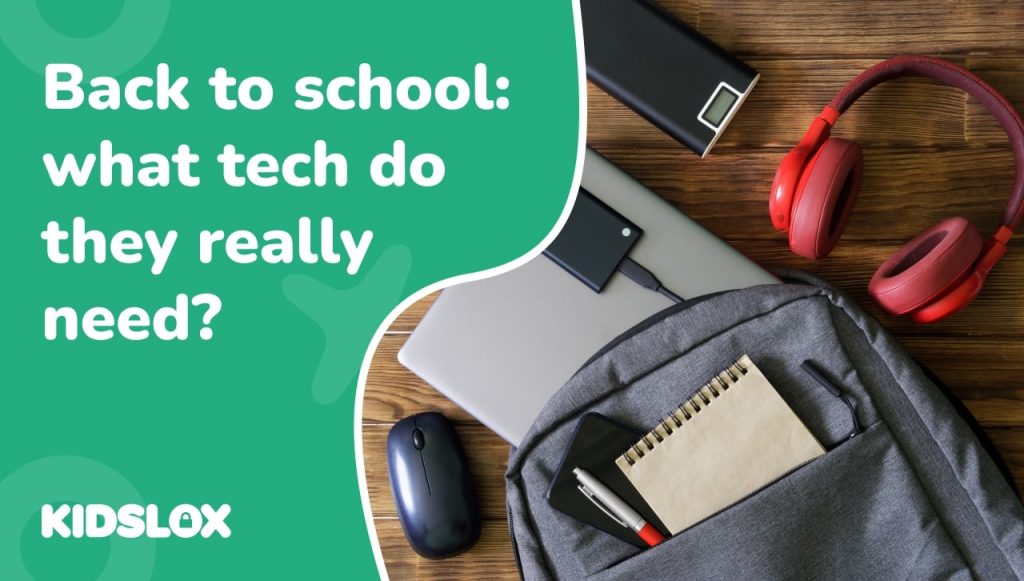It’s back to school season – and for many families, it’s time to pack up the latest tech gear for a new school year. Whether your student is virtual, in-person, or both – having the right equipment and knowing how to use it can make all the difference in their learning success.
Yet the digital-first environment of today’s students can feel overwhelming. According to Pew Research, over a third of parents report that their children under 12 began using smartphones before hitting the age of 5. In fact, among the 60% of parents whose young children interact with smartphones, 31% indicated that this interaction started even before the age of 2!
Should students have access to the latest and greatest tech – or should they be content with what’s available at home? What are the potential pitfalls of having too much tech or not enough?
To help you start the school year right, let’s take a look at must-have tech for the back-to-school season and some of the potential obstacles you should be aware of when it comes to technology and education.
Social Learning & Technology
When we reflect upon our school memories, more often than not, the friendships, group projects, recess games, and face-to-face interactions stand out, not just the lessons and grades.
That’s because school is about more than academics – it’s a microcosm of the larger world where students learn vital life skills.
In school, children develop social skills that they’ll carry with them throughout their lives. They learn about teamwork, empathy, communication, patience, and more.
These interactions teach them about diversity, understanding different perspectives, handling conflicts, and forming relationships. In the classroom, students learn the art of conversation, the joy of shared laughter, and even the occasional pain of disagreements or feeling left out.
However, there’s a growing concern that with the surge in personal tech devices, students are missing out on these crucial real-world experiences. Why strike up a conversation when you can immerse yourself in a game? Why enjoy the outdoors during recess when you can watch a YouTube video?
For today’s kids, tech is an integral part of their lives. And while too much of it can be disruptive, we also can’t deny that being utterly unfamiliar with contemporary tech or pop culture can inadvertently lead to social isolation.
Consider the child who hasn’t heard about the latest trending game or app. In conversations, they might feel left out, or, worse, become the subject of ridicule or bullying for not “fitting in.”
So, what’s the middle ground? It’s about balance and mindful integration. Technology should be viewed as a tool, not a crutch. Students can be encouraged to leverage tech for group projects, to research together, or even to enjoy a shared gaming session occasionally.
Tech Must-Haves for School
To help us strike that balance between too much and not enough tech, let’s look at some of the main categories of “must-haves” students will need to succeed. While schools may provide some of these, other items should be considered and, if possible, integrated into the student’s learning experience.
Study Aids:
In today’s digital age, the sheer volume of educational resources available at our fingertips is astounding. Certain tools can streamline the learning process and offer a more immersive experience:
- Note-Taking Apps: Gone are the days of losing paper notes – and while paper and pen are still used in school, tablets are taking center stage. Apps like Notion or Microsoft OneNote can organize, store, and even sync notes across devices. Their search functionality also allows for easy retrieval of information. On tablets, apps that allow for handwriting can be a great way to take notes and annotate documents.
- Digital Textbooks: Students can now purchase their textbooks in digital form, making them easier to carry around and access on the go. Digital textbooks are also often cheaper than paper copies. They may even have embedded features that enable quick referencing or highlight important sections of text.
- Online Dictionaries & Thesauruses: Instant access to tools like Merriam-Webster or Dictionary.com can enhance vocabulary and writing skills. With pronunciation guides and word histories, they’re more than just definitions.
- Study Planners & To-Do Apps: Keeping track of assignments, exams, and study sessions can be a breeze with apps. They can set reminders, track progress, and help manage time effectively.
- Interactive Learning Platforms: Websites like Khan Academy, Coursera, or Duolingo provide interactive lessons in various subjects, making learning engaging and often more effective.
Communication Tools:
With collaborative projects becoming the norm, communication tools are not just desirable but essential:
- Smartphone: Depending on the student’s age, having access to a mobile device can be helpful for fast communication. Like any device, it’s essential to monitor use and limit distraction and danger.
- Tablets: A tablet is versatile – it’s great for researching, creating presentations, and even video calling for group discussions. With myriad educational apps available, it becomes a multi-functional tool.
- Safe Chat Apps for Young Students & Families: Apps can provide students, teachers, and parents a platform to communicate safely. They can be used for updates, queries, or even to share achievements.
Distance Learning & Crisis Preparedness:
The recent pandemic underscored the need to be technologically prepared. As classrooms shifted online, tech became the bridge between teachers and students. Now, this tech has become almost indispensable for remote teaching.
- Quality Laptop or Tablet: A device with a good processor, sufficient storage, and a clear display is a must. It’s the primary tool for attending virtual classes, accessing resources, and completing assignments.
- Reliable Internet Connection: A stable, high-speed Internet connection ensures students can attend online classes without interruptions, download resources quickly, and participate in group discussions smoothly.
- Headphones with Mic: Essential for attending online classes without disturbing others and for clear communication. Noise-canceling variants can provide extra concentration in noisy environments (and peace of mind for parents!)
- Webcam: A built-in or external webcam is crucial for interactive classes and presentations. Many modern laptops and tablets have these features included.
- Essential Software/Apps: Based on the school’s chosen platform, software like Zoom, Microsoft Teams, or Google Classroom might be required. Having these set up and familiarizing oneself with their functionalities is beneficial.
Back-To-School Tech Potholes to Avoid
1. Over-Reliance on Tech:
Technology can be a double-edged sword. While it offers various tools and resources to support learning, over-dependence can lead to reduced physical activity, lack of hands-on experiences, and diminished face-to-face interactions.
Tip: Set specific “tech-free” hours daily, encouraging children to indulge in physical activities, read books, or engage in hobbies. Making tech usage a reward – rather than a constant – can help maintain a healthy balance.
2. Distractions Galore:
The internet is full of tantalizing distractions, from social media to games, which can lead students away from their primary academic tasks. Such diversions can reduce concentration levels, making learning superficial.
Tip: Designate specific devices or user profiles for study purposes, free from non-academic apps and notifications. Teach kids the Pomodoro Technique – focusing on a task for 25 minutes and then taking a 5-minute break, which can improve concentration and productivity.
3. Cyber Threats & Digital Footprints:
The online world is rife with potential hazards – from cyberbullying, phishing, and malware to inappropriate content. Moreover, every online action contributes to one’s digital footprint, which can have long-lasting consequences.
Tip: Educate children about the importance of strong, unique passwords and the dangers of sharing personal information online. Encourage open dialogues about their online experiences and acquaint them with the concept of a digital footprint and its potential impact.
4. Social Isolation:
An excessive focus on screens can make children feel disconnected from the real world, leading to feelings of loneliness or depression, missing out on real-world experiences, and a lack of essential social skills.
Tip: Prioritize group activities or enroll children in clubs or workshops, which can help them interact with peers and develop social skills. Setting up playdates, sports events, or community service can also help foster interpersonal relationships.
5. The Need for Parental Safety Controls:
As tech becomes more integrated into children’s lives, there’s an increasing risk of exposure to inappropriate content or oversharing personal information. Talking about the dangers might not be enough; proactive measures are essential.
Tip: Implement parental controls on devices, limiting access to age-appropriate content. Using third-party apps like Kidslox can be instrumental.
These tools not only help in monitoring screen time but also in ensuring a safe and conducive digital environment. Parents can ensure their child’s online safety by setting rules around device use while also promoting responsible tech habits.
Make It A Great School Year with Kidslox
Navigating the digital landscape as a parent in today’s fast-paced world is undeniably challenging. With its vast array of tools and resources, technology offers excellent learning and growth opportunities for our children and teens. Yet, like any tool, its benefits come hand in hand with potential pitfalls.
The key lies in finding the right balance — leveraging technology’s advantages while staying wary of its potential drawbacks. The tips above can help you get started on the path to a safe and enjoyable digital experience for your family.
Parents, educators, and students must collaboratively foster a landscape where technology enhances learning experiences, fosters genuine connections, and promotes individual growth. It’s a journey that requires awareness, proactive measures, and sometimes, a little help from digital allies.
For those looking to ensure the digital well-being of their loved ones, look no further than Kidslox.
More than just a parental control app, Kidslox provides the ultimate protection for your family’s devices, ensuring a safe, balanced, and enriching digital experience for all. Track use on all your devices, set custom screen time limits, block dangerous and inappropriate websites, and more.
Start your family’s digital journey on the right track today with Kidslox! Sign up now to get the peace of mind you deserve – and make this year one of connection, growth, and discovery.





